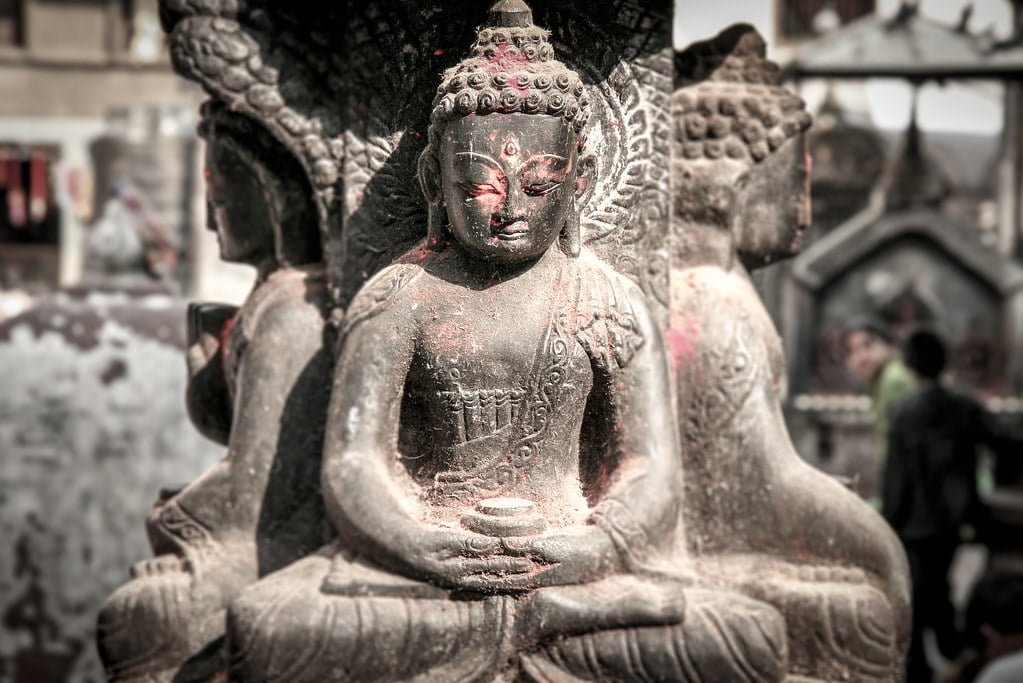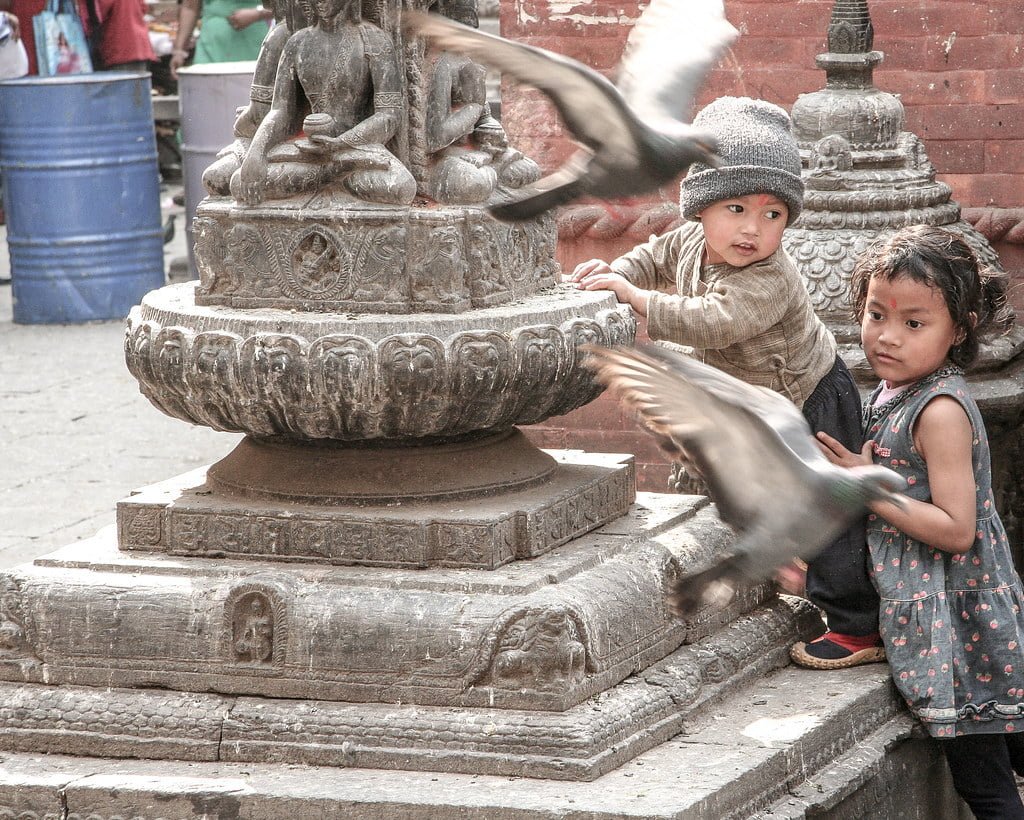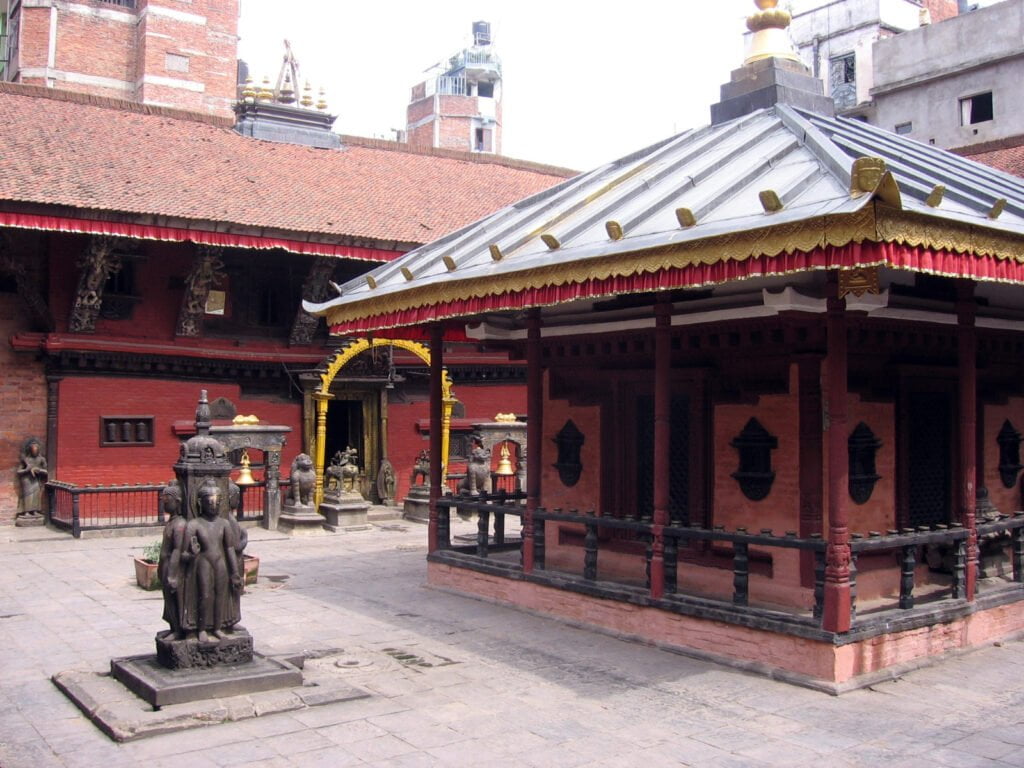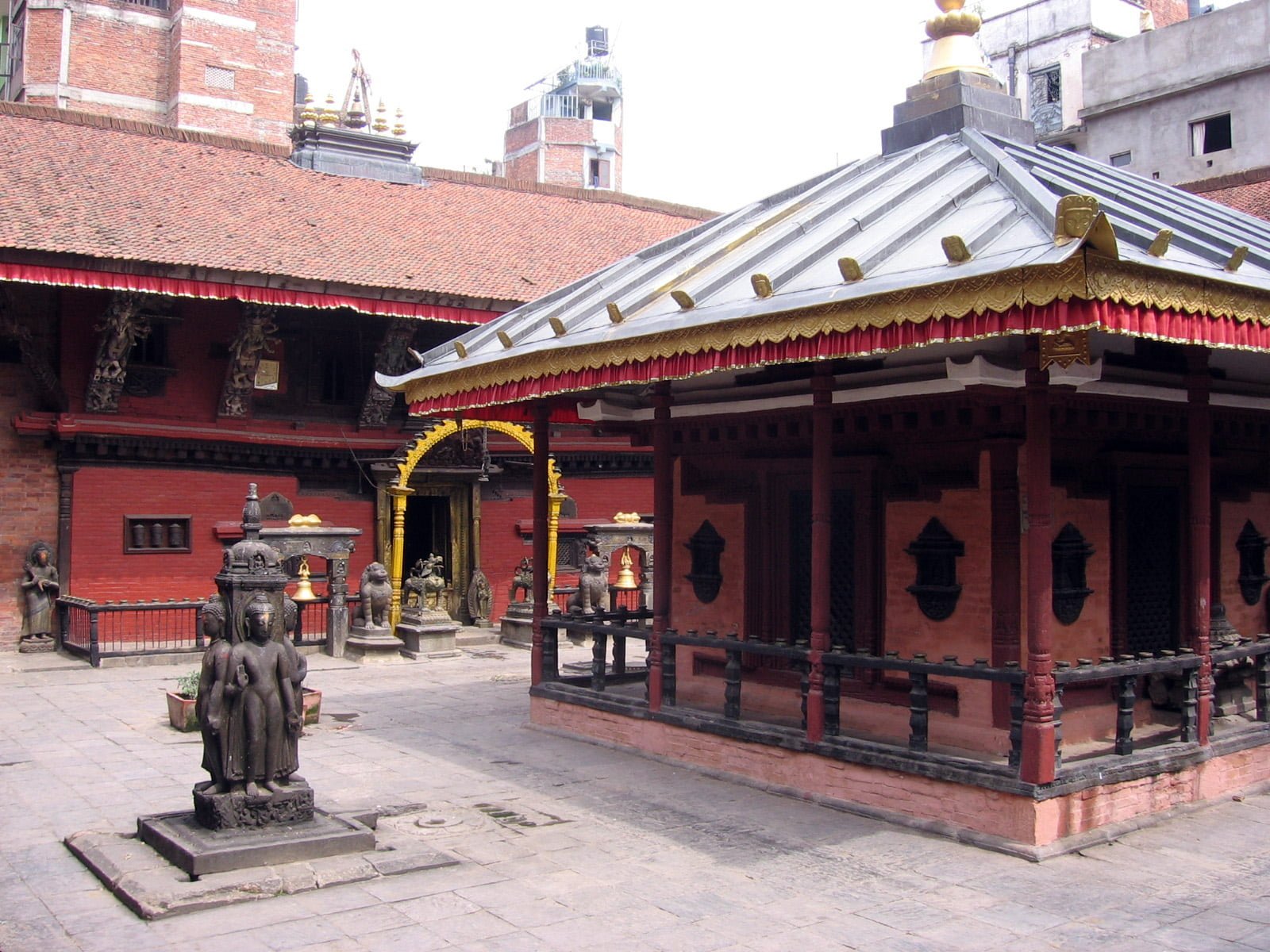Itum Bahal: A Hidden Gem in the Old City
Nestled in the heart of Kathmandu’s old city, Itum Bahal stands as a hidden gem waiting to be explored. This ancient Buddhist monastery, situated in ward 26, is located halfway between the bustling tourist hub of Thamel and the historic Kathmandu Durbar Square. While the main entrance is along Kilagal street, it is worth noting that street signs are scarce in Kathmandu, so following a heritage walk or having a knowledgeable guide could greatly enhance your visit.
As you enter Itum Bahal, you will be greeted by the sight of black stone chaitya, which are Buddhist monuments adorned with intricate carvings of the Buddha. This fusion of Buddhism and Hinduism is a hallmark of the Newar culture, the indigenous people of the Kathmandu Valley who are renowned for their architectural masterpieces. Itum Bahal is no exception, showcasing the rich craftsmanship and heritage of the Newari people.
While many city tours and guides may overlook the significance of Itum Bahal, it is a place that should not be missed. Unfortunately, some guides are driven by commercial interests and lack a deep understanding of the Newari origins of the city. However, if you are fortunate enough to have a guide who takes pride in sharing the beauty of Newari culture, you will gain a deeper appreciation of this enchanting monastery.
One of the notable features within Itum Bahal is the presence of the Talking Tara, also known as White Tara. According to local legend, she flew from Tibet and found her home in the side courtyard of Itum Bahal. This sacred site is associated with Guru Mapa, a cannibal demon, and Kescandra, a trader who had dealings with him. The temple wall itself bears the inscription of the name Mahasantasvetadharmacakratara, adding to the mystical aura of the place.
Adjacent to Itum Bahal is the Koti Mahadev temple, a unique attraction that should not be missed. As you explore the area surrounding Itum Bahal, you will also come across vibrant markets along Kigali street, where vendors sell everything from fresh produce to delectable snacks, aromatic spices, and precious minerals. While there are no restaurants or shops within Itum Bahal itself, the popular tourist hub of Thamel is just a stone’s throw away, offering a variety of international-themed eateries to satisfy your culinary cravings.
To truly make the most of your visit to Itum Bahal, it is advisable to consult guidebooks that delve deeper into the rich history and cultural significance of this hidden gem. These guidebooks will provide you with detailed information on how to get to Itum Bahal and offer recommendations for nearby accommodations. Additionally, they can provide comprehensive reviews of the best dining options in Thamel, ensuring that your gastronomic adventures are memorable.
History of Itum Bahal
Itum Bahal holds a rich and fascinating history that intertwines legends, folklore, and religious significance. It is one of the oldest bahals, or monasteries, in Kathmandu and has remained a significant cultural and religious landmark in the city.
According to local legends, Itum Bahal’s history is closely associated with the cannibal demon known as Gurumapa. The demon, notorious for devouring the residents of Itum, became a threat to the community. In an attempt to protect themselves and their loved ones, the residents of Itum devised a plan. Keshchandra, a prominent figure in the community, took Gurumapa to the open field at Tudikhel, promising him a grand feast every year if he stayed away from Itum.
Since then, a feast of rice and buffalo meat has been held at Tudikhel annually to satiate Gurumapa and ensure the safety of Itum. This fascinating legend has been immortalized through bronze plaques that line the northern wall of Itum Bahal, depicting the story of Keshchandra and the cannibal demon.
Apart from this intriguing tale, Itum Bahal also boasts historical significance. It was one of the first buildings constructed in the Kathmandu Valley, with its foundations believed to date back to the Licchavi Period (300–879). This makes Itum Bahal a true testament to the enduring religious traditions and architectural heritage of the region.
The monastery itself is a two-story complex built around a central courtyard. Inside, visitors can find various religious artifacts and wooden figures, including a remarkable four-faced, six-armed deity known as Mahapratisara. This deity, believed to be from the 17th century, is a local symbol of divine protection and represents the deep spiritual roots of Itum Bahal.
Despite its historical significance and cultural importance, Itum Bahal has managed to remain relatively untouched by tourism. This is a blessing for visitors as it means they can experience the authentic local side of Newari Kathmandu, away from the crowds and touts that often accompany other tourist sites.
As one explores Itum Bahal, they can’t help but be captivated by its intriguing history and the legends that have shaped its identity. From the tales of Gurumapa to the ancient Licchavi foundations, Itum Bahal is not just a monastery but a living testament to the rich cultural heritage of Kathmandu.

Iconic Chaitiyas and Images
The White Tara Chaitya
The White Tara Chaitya is a significant structure located in the Itum Bahal courtyard in Kathmandu. It is a large white chaitya that holds great reverence among the local community. While it may be commonly referred to as a stupa, it is important to note that it does not contain the relics of the Buddha or been blessed as a stupa. Nevertheless, its grandeur and spiritual significance make it a remarkable sight to behold.
Situated in the middle of the courtyard, the White Tara Chaitya is surrounded by smaller black stone chaitya to its left. This creates a visually striking contrast and adds to the overall aesthetic appeal of the area. The chaitya symbolizes the spiritual journey and the path to enlightenment.
The White Tara Chaitya holds a special place in the hearts of the Newari Buddhist community. It is part of a larger complex that includes other representations of Tara, such as the Green Tara and Prajnaparamita Tara. These deities are revered by the local community, and special rituals are observed in their honor.
The courtyard itself is a place of tranquility and contemplation. As you approach the White Tara Chaitya, you will pass by a large tree known as the tree of life. Colorful strings are tied around it to mark significant events such as the birth or death of a loved one. This tree serves as a reminder of the cyclical nature of life and the interconnectedness of all beings.
The White Tara Chaitya also holds historical significance. It is believed that it was brought to the Itum Bahal from Tibet by the Talking Tara. The Talking Tara, also known as Sheto Tara, is said to have flown to Kathmandu and settled in this courtyard. The temple wall bears an inscription with the name Mahasantasvetadharmacakratara, further adding to its historical and cultural importance.
It is worth noting that the Itum Bahal suffered damage during the 2015 earthquake but was completely repaired in 2017. The restoration of the White Tara Chaitya and its surrounding structures is a testament to the resilience and dedication of the local community in preserving their cultural heritage.

The Black Stone Chaitya
One of the notable features of Itum Bahal is the presence of black stone chaitya. These Buddhist structures can be found to the left as you enter the main courtyard. The black stone chaitya are adorned with intricate carvings of the Buddha, showcasing the fusion of Buddhism and Hinduism in the Newar culture.
The Newar people, known for their architectural prowess, have contributed greatly to the temples and monuments that grace the Kathmandu Valley, and Itum Bahal is no exception. While the open courtyard may appear unimpressive at first glance, exploring further reveals the hidden beauty and significance of this Buddhist monastery.
The black stone chaitya serve as a reminder of the deep-rooted traditions and beliefs that permeate the Nepalese culture. Buddhism and Hinduism coexist harmoniously in the Newar community, and the black stone chaitya stand as a testament to this harmonious fusion. The carvings on these chaitya tell stories of the Buddha’s teachings and symbolize the reverence and respect that the Newar people hold for both religious traditions.
Moreover, the black stone chaitya are not just ordinary structures; they hold a deep spiritual significance. They are sacred spaces for meditation and contemplation, inviting devotees to seek enlightenment and inner peace. As visitors explore Itum Bahal, they are encouraged to take a moment to reflect and embrace the serenity that emanates from these stone structures.
The black stone chaitya are not just architectural marvels; they represent a rich tapestry of history, spirituality, and cultural heritage. They serve as a bridge between the past and the present, reminding us of the enduring legacy of the Newar people and their contributions to the religious and artistic landscape of Nepal.
Visitors to Itum Bahal are urged to appreciate the intricate craftsmanship and symbolism embedded in the black stone chaitya. These structures are not just visually captivating; they hold stories and teachings that have been passed down through generations. As one stands before these chaitya, it is an opportunity to connect with the spiritual essence of the Newar culture and gain a deeper understanding of the profound wisdom and enlightenment that Buddhism embodies.
Brass Plaques and Magical Power
One of the intriguing features of Itum Bahal, Kathmandu’s largest Buddhist monastery, is the series of brass plaques adorning the walls near the golden gates. These plaques depict a terrifying monster known as Gurumapa, who is a central figure in Newari folklore.
The brass plaques not only serve as decorative elements but also hold significant cultural and religious significance. They are believed to possess magical powers and are revered by the locals. The depiction of Gurumapa devouring someone serves as a cautionary tale and a symbol of protection against evil forces.
According to the popular folklore, Gurumapa is linked to the founding of Itum Bahal by a man named Keshchandra. The story goes that Keshchandra, while living in the monastery’s courtyard, lost all his money gambling. In response, his sister taught him a valuable lesson by feeding him rice on the floor. This act of humility and introspection led Keshchandra to seek spiritual guidance, eventually leading to the establishment of Itum Bahal.
The brass plaques depicting Gurumapa remind visitors of the transformative power of self-reflection and the consequences of one’s actions. They serve as a visual representation of the monastery’s teachings and the importance of overcoming one’s vices.
The magical power attributed to these brass plaques is believed to offer protection and ward off negative energy. Visitors often touch or pray near these plaques, seeking blessings and divine intervention. The plaques are regarded as a source of strength and a tangible connection to the spiritual realm.
The craftsmanship and intricate details of the brass plaques further enhance their allure. Each plaque is a work of art, showcasing the skill and creativity of the artisans who crafted them. The symbolism and imagery depicted on the plaques add depth and meaning to their presence within the monastery.
Beyond their aesthetic appeal, the brass plaques serve as reminders of the rich cultural heritage and traditions of the Newar people. They are a testament to the fusion of Hindu and Buddhist influences, reflecting the harmonious coexistence of these two religions in Nepal.

Spiritual Significance
Connection to Buddhist Monasteries
Itum Bahal, also known as Shree Bhaskar Deva Sanskarit Kesh Chandra Krit Parawarta Mahavihar, holds a significant place among the Buddhist monasteries in Nepal. Dating back to the 11th century, this monastery has a rich history and connections to the Buddhist tradition.
According to local legends, Itum Bahal was built after Gautam Buddha visited the Kathmandu valley during the Kirant rule. It is believed that Buddha resided in a small kuti (cottage) with monks and nuns in a place called Puchhagara Chaitya. This visit by Buddha is said to have inspired the construction of a monastery in the valley, which eventually became Itum Bahal.
While there may not be extensive historical evidence to support these legends, the presence of Itum Bahal as one of the oldest monasteries in the area attests to its importance in the Buddhist tradition. It is believed that the main monastery was built on the site of a pre-existing Buddhist shrine, adding to its spiritual significance.
Itum Bahal’s connection to other Buddhist monasteries in Nepal is also evident in its architecture and artifacts. The monastery’s courtyard features a medium-sized shrine with a Shiva lingam inside, showcasing the influence of Hinduism in the Newar cultural presence. This coexistence of Hindu and Buddhist elements reflects the intermingling of religious traditions in Nepal.
Influence of the Gurus
The Gurus of the Kathmandu Valley, namely Mina, Gorakhnath, and Macchendranath, have had a significant influence on the spiritual and cultural landscape of the region. These revered Gurus are considered as embodiments of enlightened beings and have left a lasting impact on the religious practices and beliefs of the people.
One of the major influences of these Gurus is the transmission of esoteric teachings and practices. Through their teachings, they have imparted sacred knowledge and wisdom to their disciples, enabling them to attain spiritual liberation and enlightenment. The Gurus have played a crucial role in preserving and disseminating ancient tantric traditions, such as the practice of mahamudra, which is a path to realizing the ultimate truth.
Moreover, the Gurus have contributed to the development and evolution of religious rituals and ceremonies. They have introduced innovative practices that involve the use of mantras, mudras, and visualizations, which are believed to have transformative effects on the practitioners. These rituals and ceremonies continue to be an integral part of the religious fabric of the Kathmandu Valley.
Furthermore, the Gurus have fostered a deep sense of devotion and reverence among their followers. Their teachings emphasize the importance of cultivating a strong spiritual connection with the divine and seeking guidance from enlightened masters. This devotion has led to the establishment of numerous temples, monasteries, and pilgrimage sites dedicated to these Gurus, serving as important centers of spiritual practice and worship.
The Gurus’ influence extends beyond the realm of spirituality. They have also had an impact on the cultural and artistic expressions of the Kathmandu Valley. Their teachings have inspired and influenced various forms of art, including painting, sculpture, music, and dance. Many of the religious festivals and celebrations in the region are centered around the stories and teachings of these Gurus, showcasing the rich cultural heritage and traditions of the Kathmandu Valley.
Exploring the Courtyards
The Central Courtyard at Itum Baha Monastery: A Sacred Haven of Serenity
At the heart of the Itum Baha Monastery lies its central courtyard, a sanctuary of peace and tranquility amidst the bustling streets of Kathmandu. This hidden gem holds a significant place in the history of Nepal, boasting a rich heritage that dates back centuries.
Surrounded by a two-story complex, the central courtyard is a visual delight, adorned with intricate carvings and wooden figures that depict religious imagery. It serves as a testament to the architectural brilliance of the Licchavi Period, a time when craftsmanship and devotion intertwined seamlessly.
The courtyard’s dimensions of 24.95 meters by 24.85 meters provide ample space for visitors to explore and immerse themselves in the spiritual ambiance. As you step inside, your senses are immediately awakened by the aura of reverence that permeates the air.
In the center of the courtyard stands a square shrine, a sacred abode that houses a small votive chaitya. This unique structure bears a striking resemblance to a Shiva lingam, symbolizing the divine presence that permeates every corner of Itum Baha. The shrine stands as a focal point, drawing devotees and visitors alike to offer their prayers and find solace in its divine energy.
As you wander through the courtyard, you can’t help but marvel at the meticulously carved wooden columns, windows, and doors that line its periphery. These intricate details bear witness to the skill and dedication of the artisans who crafted them, leaving behind a legacy that continues to inspire awe.
In addition to its architectural wonders, the central courtyard is home to several wooden figures, each emanating a unique aura. Amongst them, the most notable is the awe-inspiring four-faced, six-armed deity known as Mahapratisara. Dating back to the 17th century, this magnificent sculpture captivates all who lay eyes upon it, evoking a sense of reverence and wonder.
Furthermore, the central courtyard serves as a hub of community service, housing the Free Itum Clinic. This medical facility provides essential healthcare services to the local community, a testament to the monastery’s commitment to embracing compassion and selfless service.
The Monastery Courtyard
The monastery courtyard at Itum Bahal is truly a sight to behold. Spanning a vast rectangular area, it is the largest Buddhist monastery courtyard, or bahal, in the old town of Kathmandu. This magnificent space is renowned for its size, as well as its intricate architecture crafted from wood and clay.
Stepping into the monastery courtyard offers a sense of tranquility that is a stark contrast to the bustling city that surrounds it. Amidst the chaos and noise of Kathmandu, Itum Bahal provides visitors with a peaceful haven, where they can escape the hustle and bustle and find solace in its serene atmosphere.
One of the notable features of the courtyard is the Kichandra Bahal, situated towards the western side. This courtyard is one of the oldest in the city, with a history that spans six centuries. Its ancient charm and rich history add to the overall allure of Itum Bahal.
Within the interiors of the Kichandra Bahal, visitors will find a pagoda-like sanctuary. This architectural gem is a testament to the skilled craftsmanship of the artisans who created it. Its intricate details and delicate design elements showcase the artistic prowess of the era in which it was constructed.
Towards the south of the courtyard, visitors will come across a small chaitya, or Buddhist shrine. This charming structure is adorned with beautiful decorations, adding a touch of elegance to the overall ambiance of the monastery courtyard. It serves as a reminder of the spiritual significance of Itum Bahal and the role it plays in the religious landscape of Kathmandu.
As one explores the monastery courtyard, the sheer size and grandeur of Itum Bahal become evident. The combination of its historical significance and architectural beauty make it a must-visit destination for those seeking a deeper understanding of Buddhist culture and history.
Visitors to Itum Bahal can take their time to wander through the courtyard, appreciating the intricate details of the architecture and soaking in the peaceful ambiance. Whether one is a devout Buddhist or simply a curious traveler, the monastery courtyard at Itum Bahal promises to be a captivating and enlightening experience.
Heritage Preservation – Restoring and Maintaining Itum Bahal
In recent years, efforts have been made to restore and maintain the heritage of Itum Bahal. The monastery suffered damage during the devastating earthquake that struck Nepal in 2015. However, this tragedy also served as an opportunity to uncover hidden relics and artifacts that were previously concealed within the monastery.
The restoration process has involved not only repairing structural damage but also preserving the centuries-old relics that were brought to light. These relics offer a glimpse into the rich history and culture of the region. Among the treasures found is an exquisite miniature metal sculpture, showcasing the skilled craftsmanship of the past.
Preserving the heritage of Itum Bahal is not only important for the local community but also for future generations. It provides a link to the past, allowing us to understand and appreciate the cultural heritage of Kathmandu. By maintaining the authenticity of the monastery, Itum Bahal offers a unique and enriching experience for visitors, free from the crowds and commercialization often associated with tourist attractions.
Efforts to restore and maintain Itum Bahal have been supported by local authorities, heritage organizations, and the community itself. These collaborations ensure that the restoration work is carried out with expertise and sensitivity, respecting the historical and cultural significance of the site.

